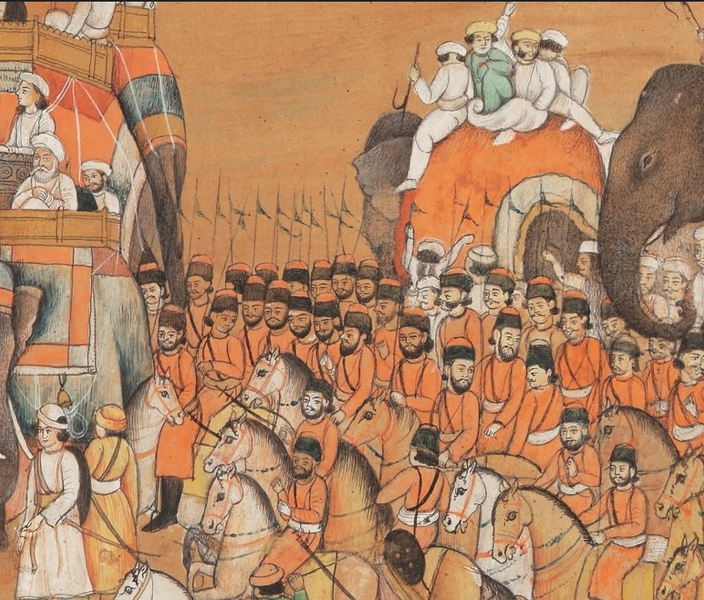Introduction
Babur founded the Mughal empire in 1526 after defeating Ibrahim Lodi in the First Battle of Panipat. In order to establish the empire, Babur had to command a number of military campaigns. Expeditions of Babur include-
- The Battles of Khanwa (1527)
- The Battles of Chanderi(1528)
- The Battles of Ghagra (1529).
It took almost two decades for Akbar, who rose to the Mughal throne in 1556, to establish his authority and bring central and northern India under his control. His reign saw some significant military campaigns, such as the Second Battle of Panipat in 1556 and the Battle of Haldighati. A number of military conquests were led by Akbar’s successors, Jahangir, Shahjahan, and Aurangzeb, to further the empire’s reach in Mewar, Deccan, Kangra, and Bengal.
Mughal Military Campaign
Gunpowder tactics, in which the Mughals employed cannons to beat their enemies, and well-trained cavalry were the reasons behind the military campaigns’ success. We shall examine in depth the three occasions when the Mughal military campaigns refused to carry on campaigns due to the fear of seasons in those regions.
- A campaign headed by prince Murad Bakhsh in Balkh
- Mughal’s Military campaign in Kashmir
- Mughal Conquest of Assam

A Campaign Headed by Prince Murad Bakhsh in Balkh
- The Mughal emperor Shahjahan led a military expedition in the seventeenth century under the command of his younger son prince Murad Bakhsh to conquer the Uzbek city of Balkh (modern-day Afghanistan).
- This territory belonged to the Mughals and was taken by Uzbeks under Babur. Balkh’s monarch fled as soon as the Mughal army arrived, and Murad quickly took control of the region.
- Murad eventually made the decision to leave the area. So, he asked for permission to move away from that location.
- Winter was about to arrive in Central Asia at the time, and it was difficult to survive with a sizable force. This was the reason for the request for relocation.
- It was very challenging for them because of the surrounding snow, which could close roads for months and complicate logistics by making it difficult to feed both the sizable army and the horses used for the cavalry.
- Shahjahan rejected his son’s petition and instructed him to stay in position. Murad still left his subordinates there and began his return trip.
- As a result of this, Shahjahan expelled Murad from his court and his mansab was called.
Mughal’s Military Campaign in Kashmir
In 1586, the Chak dynasty of Kashmir was overthrown by the Mughal emperor Akbar.A military expedition to conquer Kashmir was planned under the leadership of Muhammed Qasim Khan. Because of the harsh winter, Mughal troops gradually began to refuse to advance during the capture of Kashmir, forcing Qasim Khan to go out and fight with the enemies on his own. The Mughal soldiers in Kashmir struggled to survive the bitter weather, rough terrain, and unbearable conditions with little to no food supplies.
The Mughal warriors were used to a hotter, more open environment, hence this campaign was difficult for them.
Mughal Conquest of Assam
- The Mughal marched in Assam and Aurangzeb dispatched an army in 1662 with Mir Jumla as its supreme commander.
- The Mughals 1663 sent an army to Assam. The Mughal army successfully conquered the region and compelled the Ahoms to seek sanctuary in the highlands.
- At the conclusion of this campaign, Aurangzeb sent an order to Assam from the Mughal court to select two officials to serve as subedar and faujdar. But, due to the difficulties of the climate they had to endure during the conquest, such as rain and floods, the commanders declined to take the position.
- Ahom took advantage of the circumstance and left their hiding place to begin attacking the Mughal invaders after seeing the helplessness of the Mughal forces.
- In addition, the warriors’ line of communication with one another and the supply of food grains were disrupted by the constant, heavy rain.
- The imperial army fled from Assam as a result of all of these.
Summary
The Mughal military campaigns began in the latter part of the fourteenth century and lasted virtually until the seventeenth. Even though the Mughals were successful in almost all of their conquests, they occasionally faced difficulties in the form of internal insurrection and persistent external pressure. Additionally, environmental considerations presented challenges for the Mughal army. As a result, campaigns like those in Kashmir and Balkh by Murad occasionally had to be abandoned due to unfavourable circumstances. Although many difficulties were faced by the Mughals, their reign is still considered the most powerful in the history of India.
Frequently Asked Questions
1.Who were the Ahoms?
Ans: The tribal communities that moved to Assam were known as Ahoms. They conquered Assam’s traditional landowner elite, known as bhuiyans. The Chhutiyas and Koch-Hajo were also captured by them in the sixteenth century. In the end, they conquered a number of local tribes and established a new, sizable state in the Brahmaputra valley.
2.When and between whom was the Haldighati Fight Fought? Who Emerged Victorious from the Conflict?
Ans: In 1576 CE, Rana Pratap and Akbar’s Rajput armies engaged in combat at Haldighati. Rana Pratap was defeated by the Mughal army under Raja Man Singh’s leadership.
3.Who was Faujdar in the Mughal Era?
Ans: The head of a garrison in the military was known as the “Faujdar” during the Mughal dynasty. These faujdars were later elevated to the position of district chiefs, or sarkars, during Akbar’s rule.